Apple iPad 2 GPU Performance Explored: PowerVR SGX543MP2 Benchmarked
by Anand Lal Shimpi on March 12, 2011 3:04 PM EST- Posted in
- Smartphones
- Apple
- iPad
- GLBenchmark
- iPad 2
- Mobile
- Tablets
GLBenchmark 2.0
GLBenchmark 2.0—as its name implies—tests OpenGL ES 2.0 performance on compatible devices. The suite includes two long benchmarking scenarios with a demanding combination of OpenGL ES 2.0 effects - texture based and direct lighting, bump, environment, and radiance mapping, soft shadows, vertex shader based skinning, level of detail support, multi-pass deferred rendering, noise textures, and ETC1 texture compression.
GLBenchmark 2.0 is the best example of an even remotely current 3D game running on this class of hardware—and even then this is a stretch. If you want an idea of how the PowerVR SGX 543MP2 stacks up to the competition however, GLBenchmark 2.0 is probably going to be our best bet (at least until we get Epic to finally release an Unreal Engine benchmark).
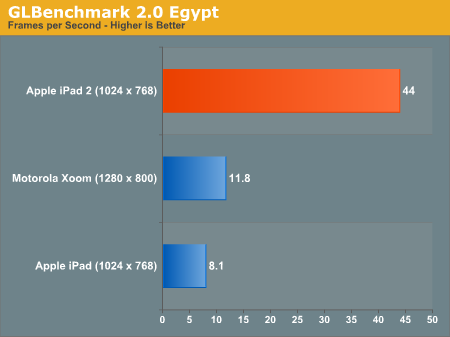
Without AA, the Egypt test runs at 5.4x the frame rate of the original iPad. It's even 3.7x the speed of the Tegra 2 in the Xoom running at 1280 x 800 (granted that's an iOS vs. Android comparison as well).
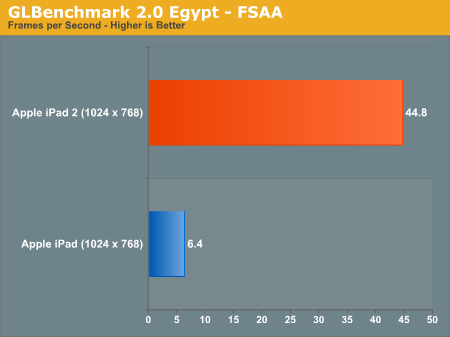
With AA enabled the iPad 2 advantage grows to 7x. In a game with the complexity of the Egypt test the original iPad wouldn't be remotely playable while the iPad 2 could run it smoothly.
The Pro test is a little more reasonable, showing a 3 - 4x increase in performance compared to the original iPad:
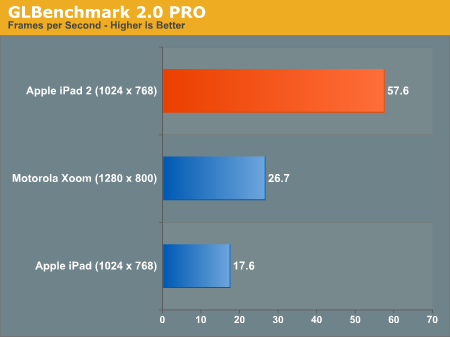
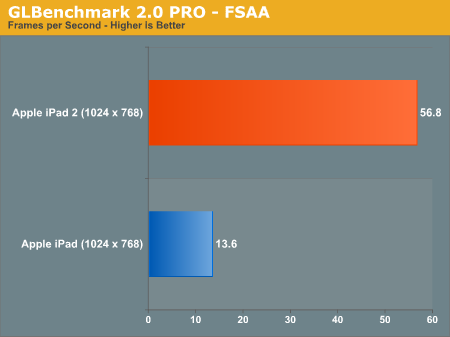
While we weren't able to reach the 9x figure claimed by Apple (I'm not sure that you'll ever see 9x running real game code), a range of 3 - 7x in GLBenchmark 2.0 is more reasonable. In practice I'd expect something less than 5x but that's nothing to complain about. We'll be doing power analysis over the weekend so expect more detail in our full review.
Putting the PowerVR SGX 543MP2 to Use: Infinity Blade
As we pointed out in our iPad 2 Preview, at least one developer already picked up on the amount of extra GPU horsepower in the new iPad 2. Epic put out an updated version of Infinity Blade with support for the iPad 2. Run it on an iPad and you'll get the same old Infinity Blade, but run it on an iPad 2 and you'll get more detail, higher resolution textures and anti-aliasing.
Remember that iPad and iPhone devices are more closed than your PC. There's no adjusting detail settings or resolution, so the target frame rate is usually what's fixed. Developers are simply able to deliver a better looking experience at roughly the same frame rate with upgraded hardware. In the case of Infinity Blade, load times are reduced thanks to the Cortex A9 CPU cores and there is some improvement in frame rate but the biggest impact comes from the improved visuals.
Below is the comparison beween Infinity Blade on the iPad and iPad 2 we ran in this morning's preview:

Mouse over to see Infinity Blade on the iPad 2
There's far more detail in the character models as well as the environment. Lighting looks improved and the AA is definitely appreciated.
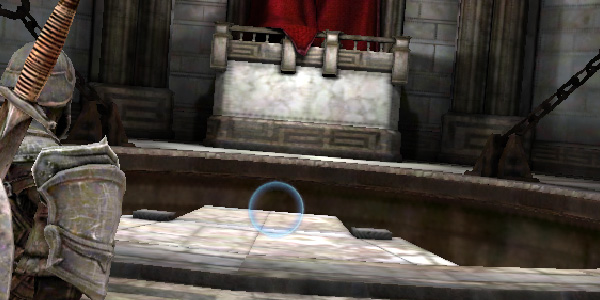
Mouse over to see Infinity Blade on the iPad 2
The gallery below has a bunch of side by side shots showing the improvements made to Infinity Blade for the iPad 2 vs. what you get when you run the game on a first generation iPad.
To Be Concluded...
We're still hard at work on our full iPad 2 review. We've got no less than four units running through battery life tests right now and there's still more to talk about in the review. We'll keep you posted, thanks for reading!


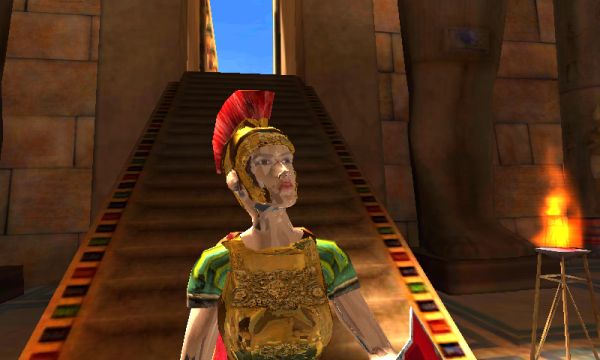














219 Comments
View All Comments
Azethoth - Saturday, March 12, 2011 - link
I think you misspelled "will scale poorly". The worst would be battery life if all 4 cores were actually doing work. Still, it would be interesting to see just how well or poorly it scales irl.tipoo - Sunday, March 13, 2011 - link
Why would it scale poorly? The 543 is built to be modular, its supposed to scale better than any other GPU solution.ncb1010 - Sunday, March 13, 2011 - link
Imagination Technologies says that the GPU scales at an efficiency of 95% when you add more cores. That is likely the rate of fallof from theoretical 2x performance when you go from 1 to 2 cores and from 2 cores to 4 cores.jalexoid - Saturday, March 12, 2011 - link
Ahem.... Actually GPUs scale almost linearly.somata - Sunday, March 13, 2011 - link
As impressive as the performance of modern low-power GPUs is, it helps to put things in perspective:Tegra 2 - 4.8 GFLOPS (8, 1-way ALUs @ ~300MHz)
PowerVR SGX543MP2 - 19.2 GFLOPS (8, 4-way ALUs @ ~300MHz??)
Radeon 9700 Pro - 33.8 GFLOPS (8, 4-way ALUs (pixel) + 4, 5-way ALUs (vertex) @ 325MHz)
Radeon 2400 Pro - 42 GFLOPS (8, 5-way ALUs @ 525 MHz)
Radeon 5450 - 104 GFLOPS (16, 5-way ALUs @ 650MHz)
Xenos (Xbox 360) - 240 GFLOPS (48, 5-way ALUs @ 500MHz)
RSX (PS3) - 255.2 GFLOPS (24, 2 x 4-way ALUs (pixel) + 8, 5-way ALUs (vertex) @ 550MHz)
Radeon 6970 - 2703.4 GFLOPS (384, 4-way ALUs @ 880MHz)
Granted, this only compares theoretical peak shader performance, and doesn't take into account the better ALU utilization of modern designs, but it should roughly correlate with general performance on modern workloads. Note that the iPad's GPU is just starting to approach Radeon 9700 (circa late-2002) levels of performance. It's impressive given the power-profile, but still nowhere near the performance of the 5-year-old consoles, and quite a bit lower than even a very low-end Radeon 2400 Pro from 2007.
The MP4 however, might come close to the Radeon 2400, depending on clocks. Once the next generation of consoles launch (hopefully next year, we'll see at E3) and game graphics likewise catch up to what modern high-end GPUs are capable of, the low-power GPUs will once again be put in their place for a number of years.
Juzcallmeneo - Sunday, March 13, 2011 - link
I'm almost positive I saw the XBox GPU scoring like twice the PS3 GPU somewhere..where did you get all these stats? I know the PS3 is capable of more graphics due to it's strange, but amazing CPU..but when comparing only GPU's the XBox's should be stronger.tipoo - Sunday, March 13, 2011 - link
"but when comparing only GPU's the XBox's should be stronger."Yeah, it probably is. The 360 has a unified shader architecture, so it automatically splits up tasks depending on the workload. The PS3's GPU has fixed function pixel and vertex shaders, meaning all their power might not be used fully at any given point.
somata - Sunday, March 13, 2011 - link
I tried to show how I derived all the figures, but perhaps you're questioning the "2 x 4-way ALUs" part that gives the RSX the edge in this comparison. Recall that RSX is based on G70, which had 24 "shader pipelines" and each pipeline had *two* 4-way FMADD units, for a total of 48. The caveat is that the instructions for both units have to come from the same instruction stream, a restriction not shared by Xenos or any other modern ALU organization.So yeah, the RSX figure is the most optimistic of the bunch. Xenos no doubt sees much better utilization, due to not sharing the above restriction, having unified shaders, and having much better branch performance. In practice I'd say the Xbox 360's GPU has superior shader performance compared to RSX, but RSX does have a bit of a texturing advantage (24 vs 16 TMUs).
coredump27 - Sunday, March 13, 2011 - link
"Once the next generation of consoles launch (hopefully next year, we'll see at E3) and game graphics likewise catch up to what modern high-end GPUs are capable of, the low-power GPUs will once again be put in their place for a number of years."Dream on!
ST Ericsson have announced their Nova A9600 mobile SoC using Imagination Technologies next gen PowerVR Series 6. Sampling later this year the GPU delivers in excess of 210 GFLOPS.
Source - http://www.stericsson.com/press_releases/NovaThor....
"The Nova A9600, built in 28nm, will deliver groundbreaking multimedia and graphics performance, featuring a dual-core ARM Cortex- A15-based processor running up to up to 2.5 GHz breaking the 20k DMIPS barrier, and a POWERVR Rogue GPU that delivers in excess of 210 GFLOPS. The graphics performance of the A9600 will exceed 350 million ‘real’ polygons per second and more than 5 gigapixels per second visible fill rate (which given POWERVR’s deferred rendering architecture results in more than 13 gigapixels per second effective fill rate). Thanks to Rogue Nova will support all existing APIs such as Microsoft DirectX. The Nova A9600 is sampling in 2011."
somata - Sunday, March 13, 2011 - link
What's to dream on about? Game consoles being released no later than next year (which may be dreaming given the current climate) or low-power GPUs not being able to catch high-power GPUs?First of all, 210 GFLOPS is still less than 1/10 of current GPU performance, and you can bet the next-gen consoles will have nothing less powerful than the current top-of-the-line. Again, I'm not dismissing Img. Tech's feat of cramming so much performance into such a small power-envelope, but does anyone realistically expect a sub-1W GPU to be able to take on GPUs that can consume 10s of watts built on the same process? You'll always be able to do more with more.
Lastly, "sampling in 2011" means we'll be lucky to see any shipping devices based on this even next year, especially ones with the "up to" specs mentioned in the PR.